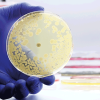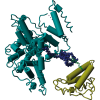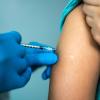This month we look at: pseudoviruses

What are pseudoviruses?
They resemble impostors and, although harmless, are designed so they can hardly be distinguished from their dangerous relatives. This makes them an invaluable tool in virus research. They can be used to precisely analyse infection pathways of dangerous virus variants.
Sounds promising.
Yes, but a major challenge so far has been to make the pseudoviruses reliably visible under the microscope, as conventional labelling methods impair the activity of the “impostors” and thus falsify the imaging.
I’m assuming there’s been some progress with this issue?
Yes – a team from the Rudolf Virchow Center for Integrative and Translational Bioimaging in Würzburg, Germany, has now developed a solution: by combining genetic code expansion and click chemistry, a unique recognition feature for pseudoviruses was created that leaves their activity unaffected.
Tell me more.
The novel “clickable” pseudoviruses are highly fluorescent. However, in terms of binding and penetration into cells, they have the same properties as their pathogenic relatives. Once inside the cells, however, they do not cause disease.
Any other advantages?
The new method has high detection efficiency. Compared to conventional immunostaining methods, the team found a detection efficiency many times higher. This makes finer details and subtle processes of the infection process visible.
What are the implications?
Professor Markus Sauer, one of the study leads, said: “This method opens up completely new horizons for us in virus research. It’s a leap forward in our ability to observe the complex dynamics of viral infections in living organisms using high-resolution microscopy methods.”
Where can I read more?
Visit bit.ly/40qnRg2 to read the paper.
Image credit | iStock




